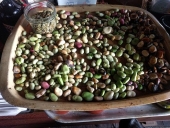
 8
8




 5
5




Celtic/fantasy/folk/shanty singing at Renaissance faires, fantasy festivals, and other events in OR and WA, USA.
RionaTheSinger on youtube.
Pop-up garden/vintage+ yard stand owner.
 7
7




Invasive plants are Earth's way of insisting we notice her medicines. Stephen Herrod Buhner
Everyone learns what works by learning what doesn't work. Stephen Herrod Buhner
 9
9





 6
6




How Permies works: https://permies.com/wiki/34193/permies-works-links-threads
My projects on Skye: The tree field, Growing and landracing, perennial polycultures, "Don't dream it - be it! "
 4
4




Nancy Reading wrote:
Peas and beans I can eat fresh, but getting them ripe enough to save is a bit of a challenge. Hopefully a combination of more experience, and selecting for early flowers will make a more suitable landrace in time.
.
“So I'm lightin' out for the territory, ahead of the scared and the weak and the mean spirited, because Aunt Sally is fixin’ to adopt me and civilize me, and I can't stand it. I've been there before.”












 4
4




Joshua States wrote:I just leave the last half-dozen or so on the vine until they turn brown and remove the beans/peas and save them for next year. Generally, I will isolate the largest pods and let them ripen.
How Permies works: https://permies.com/wiki/34193/permies-works-links-threads
My projects on Skye: The tree field, Growing and landracing, perennial polycultures, "Don't dream it - be it! "
 1
1




![Filename: Original-flowers.jpg
Description: [Thumbnail for Original-flowers.jpg]](/t/247253/a/237389/Original-flowers.jpg)
![Filename: Broken-flower-stalk.jpg
Description: [Thumbnail for Broken-flower-stalk.jpg]](/t/247253/a/237390/Broken-flower-stalk.jpg)
![Filename: Flower-bucket.jpg
Description: [Thumbnail for Flower-bucket.jpg]](/t/247253/a/237391/Flower-bucket.jpg)
![Filename: Flower-power.jpg
Description: [Thumbnail for Flower-power.jpg]](/t/247253/a/237392/Flower-power.jpg)
![Filename: New-flower.jpg
Description: [Thumbnail for New-flower.jpg]](/t/247253/a/237393/New-flower.jpg)
“So I'm lightin' out for the territory, ahead of the scared and the weak and the mean spirited, because Aunt Sally is fixin’ to adopt me and civilize me, and I can't stand it. I've been there before.”
 2
2




Weeds are just plants with enough surplus will to live to withstand normal levels of gardening!--Alexandra Petri
 2
2




Zone 6, 45 inches precipitation, hard clay soil








![Filename: Broc-pods-V2.jpg
Description: [Thumbnail for Broc-pods-V2.jpg]](/t/247253/a/237639/Broc-pods-V2.jpg)
“So I'm lightin' out for the territory, ahead of the scared and the weak and the mean spirited, because Aunt Sally is fixin’ to adopt me and civilize me, and I can't stand it. I've been there before.”
 2
2




'What we do now echoes in eternity.' Marcus Aurelius
How Permies Works Dr. Redhawk's Epic Soil Series
 5
5




Joshua States wrote:
I just leave the last half-dozen or so on the vine until they turn brown and remove the beans/peas and save them for next year. Generally, I will isolate the largest pods and let them ripen.
Nothing ruins a neighborhood like paved roads and water lines.
 2
2









“So I'm lightin' out for the territory, ahead of the scared and the weak and the mean spirited, because Aunt Sally is fixin’ to adopt me and civilize me, and I can't stand it. I've been there before.”
 4
4




It's never too late to start! I retired to homestead on the slopes of Mauna Loa, an active volcano. I relate snippets of my endeavor on my blog : www.kaufarmer.blogspot.com












 3
3




Su Ba wrote: so that I can plant them within a couple of weeks once I harvested them.
How Permies works: https://permies.com/wiki/34193/permies-works-links-threads
My projects on Skye: The tree field, Growing and landracing, perennial polycultures, "Don't dream it - be it! "






 3
3




It's never too late to start! I retired to homestead on the slopes of Mauna Loa, an active volcano. I relate snippets of my endeavor on my blog : www.kaufarmer.blogspot.com
 5
5




Creating edible biodiversity and embracing everlasting abundance.












 4
4




How Permies works: https://permies.com/wiki/34193/permies-works-links-threads
My projects on Skye: The tree field, Growing and landracing, perennial polycultures, "Don't dream it - be it! "
 4
4













|
You had your fun. Now it's time to go to jail. Thanks for your help tiny ad.
Freaky Cheap Heat - 2 hour movie - HD streaming
https://permies.com/wiki/238453/Freaky-Cheap-Heat-hour-movie
|





